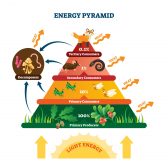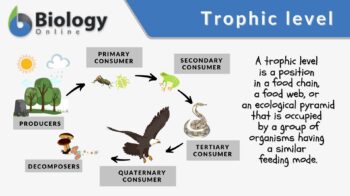
Trophic level
n., plural: trophic levels
[ˈtɹoʊfɪk ˈlɛv.əl]
Definition: a level or a position of a group of organisms in a food chain, or a food web, or an ecological pyramid
Table of Contents
In ecology, a trophic level pertains to a position in a food chain or ecological pyramid occupied by a group of organisms with similar feeding modes. A food chain refers to the hierarchy in which organisms in an ecosystem are grouped into trophic (nutritional) levels. The trophic levels are shown in a series or a succession to represent the flow of food energy and the feeding relationships between them.
An ecological pyramid, in turn, represents the biomass or the energy flow in an ecosystem. Both the food chain and ecological pyramid start at trophic level 1, which is comprised of primary producers. The next trophic group is comprised of organisms that feed on the primary producers to obtain nutrition.
Then, the succeeding groups are each comprised of a group of organisms that feed on the group before them. The succession of trophic levels may occur in a one-way chain or in more intricate trophic paths called the food web. A food web is comprised of many food chains that are linked together. Most ecosystems have a complex web structure rather than a direct chain of what-eats-what.
Trophic Level Definition
A trophic level refers to a level or a position in a food chain, a food web, or an ecological pyramid. It is occupied by a group of organisms that have a similar feeding mode. In an ecological pyramid, the various trophic levels are primary producers (at the base), consumers (primary, secondary, tertiary, etc.), and predators (apex). There are essentially two major types of organisms based on their feeding mode:
- Autotrophs that can produce organic matter (food) from inorganic sources
- Heterotrophs that do not have such an ability and therefore feed on other organisms
Etymology: The term trophic came from the Greek trophē, meaning “food”
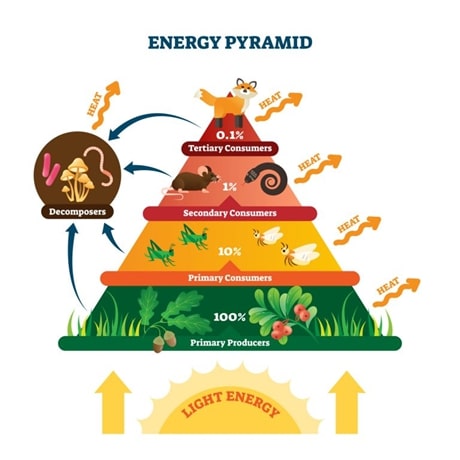
Categories
The trophic levels have two major categories: the autotrophs and the heterotrophs. Autotrophs are organisms that can produce organic matter from inorganic matter. Since they can make their own food and do not need to feed on other organisms, they are also referred to as the producers of an ecosystem. Heterotrophs are organisms that obtain organic matter directly by consumption. Unlike autotrophs, they do not have the ability to manufacture their food from inorganic sources.
Thus, they hunt or gather food from other organisms. Heterotrophs are therefore referred to as the consumers. They may be further grouped into primary consumers, secondary consumers, tertiary consumers, and so on. The primary consumers are comprised of plant-eating organisms called herbivores.
The secondary consumers feed on the primary consumers. The tertiary consumers feed on the secondary consumers, and so on. The final group called reducers feeds on dead organic matter. They include the detritivores and the decomposers.
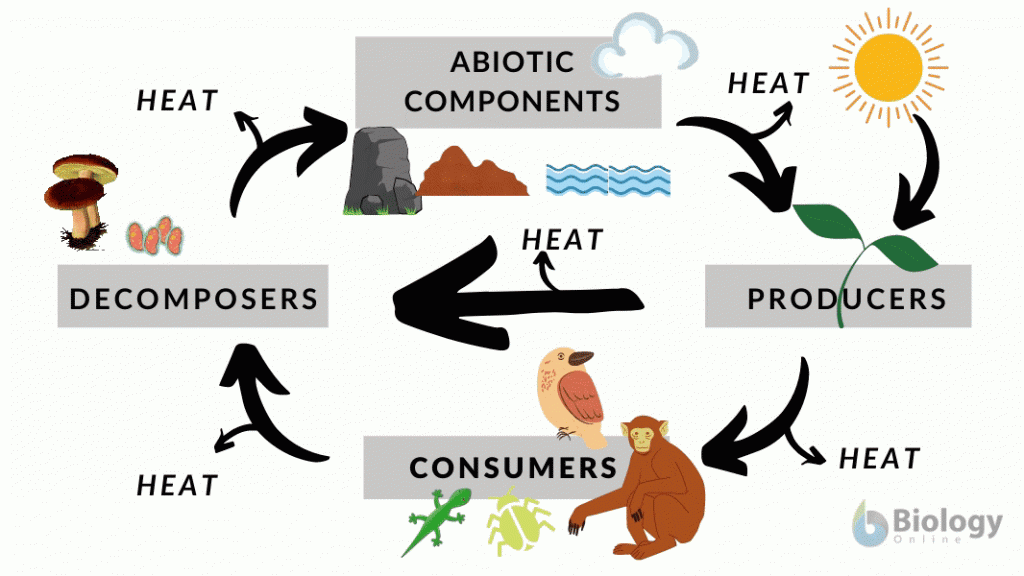
Trophic Structure
Trophic structure refers to the partitioning of biomass between different trophic levels. It is controlled chiefly by the biomass of the primary producers. The primary producers affect the transfer efficiency between trophic levels as they essentially provide the energy and the nutrient inputs. Apart from them, another important factor is the top-down component.
The latter includes the predators. Their consumption suppresses the lower trophic levels. In a way, the predators help the primary producers by controlling or limiting excessive herbivory by predation. They serve as biological control of the lower trophic levels. Another way by which the predators are able to promote primary productivity is by intraspecific competition. Both the primary producers and the predators are major factors for regulatory control. (1)
Trophic Level Pyramid
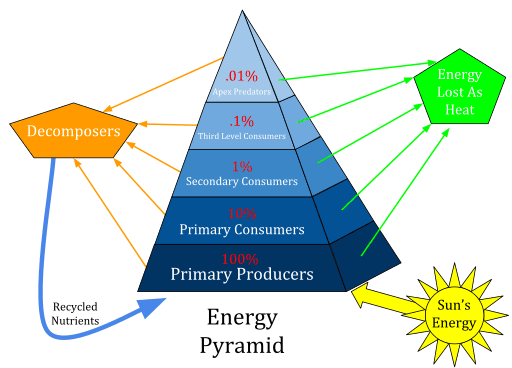
An ecological pyramid is often depicted as a trophic-level pyramid. It is a graphical representation in the shape of a pyramid comprised of plants and animals in a certain ecosystem. The shape indicates that the bottom trophic level is comprised of organisms that can make their own food through available sources from the environment.
They do not feed on other organisms to obtain their nutritional requirements. Thus, they represent the base. This portion of the pyramid is comprised of producers. As the trophic levels go up, it tapers towards the peak. This pyramid shape depicts the biomass in each trophic level. Biomass is the amount of living or organic matter in an organism.
The base shows the largest biomass and then diminishes in amount as it moves up to the apex. This is the most common structure in ecosystems. However, there are also instances wherein an inverted pyramid occurs. The latter results when the combined weight of producers is smaller than the combined weight of consumers.
The ecological pyramid is also sometimes referred to as the Energy Pyramid. This is because it similarly depicts the trophic levels’ energy, i.e. the energy flow through the various trophic levels. The highest energy is often found at the base that producers occupy. As the trophic structures progress to the top, the energy flow is depicted to diminish from the bottom to the top.
Trophic Level Examples
Here are examples of trophic levels.
Level 1: Producers
Trophic level 1 is comprised of primary producers. They are found at the base of an ecological pyramid. A food chain would start as well at trophic level 1. The trophic level 1 is occupied by plants and algae. The fundamental feature of organisms in trophic level 1 is their ability to produce their own food from abiotic materials.
Plants, for instance, are able to manufacture their food by photosynthesis. This process can be simplified in this equation: 6CO2+12H2O+energy=C6H12O6+6O2+6H2O. It means photosynthesis is a process in which carbon dioxide (CO2), water (H2O), and light energy are utilized to synthesize an energy-rich carbohydrate like glucose (C6H12O6) and to produce oxygen (O2) as a by-product. Structurally, plants and algae have light-harvesting cellular structures called chloroplasts. Inside the chloroplasts are photosynthetic pigments (chlorophyll) that can absorb light energy.
Level 2: Primary consumers
The next trophic level in a food chain or an ecological pyramid is trophic level 2. In this level, the organisms occupying this level feed on the primary producers and are called primary consumers. Animals that feed on plant materials are called herbivores. They have anatomical and physiological features that make them adapt to a plant diet.
Typically, they have mouthparts that enable them to rasp or grind plant materials. For example, they have wide flat teeth for grinding foliage and tree bark. They also have a gut flora (comprised of cellulose-digesting protozoans or bacteria) that helps digest cellulosic material. Examples of herbivores are horses, cattle, and goats.
Level 3: Secondary consumers
Secondary consumers are comprised of animals that feed on primary consumers. Organisms that eat other animals are called carnivores (or predators). Predators occupy the trophic level 3 of a food chain or an ecological pyramid. Predation is an interaction in an ecosystem where a predator hunts or catches, kills, and eats prey. Predators are, in turn, adapted anatomically and physiologically for an animal diet.
Since prey consumption could involve pursuit or ambush they often have advanced senses for vision, hearing, touch, or smell. They could also employ camouflage or mimicry so as to prevent getting noticed by potential prey. They have fangs, sharp claws, and strong jaws to grip and cut up their prey.
Similarly, the prey eventually gained evolutionary features to foil predation. They developed counter-adaptations and defense strategies, such as thanatosis, alarm calls, warning coloration, spines, chemicals, mimicry, and camouflage.
Examples of animals with a predator-prey relationship are spiders and flies, lion and zebra, bear and fish, and fox and rabbit. (2) Apex predators are predators in which no animal preys on them. The killer whales are an example. Their marine prey are fish, seals, and dolphins.
Not all predators though have a diet exclusive of meat. Their diet may also include plant materials. Animals that feed on both plants and animals are called omnivores. Omnivores may also derive their nutrition from fungi, algae, and bacteria. (3) Compared with other animal groups such as carnivores and herbivores, omnivores lack distinctive specializations in acquiring and processing food.(4)
Examples of omnivores are chimpanzees, orangutans, gorillas, pigs, most bears, hedgehogs, opossums, skunks, sloths, squirrels, mice, rats, rodents, raccoons, and many others. These animals feed on more than one trophic level. Most humans are omnivores. However, some of them prefer to eat a plant-based (vegan) diet.
Carnivorous plants (e.g. insectivorous plants like Venus flytrap and pitcher plants) may also be included in this group. These plants are capable of predation as another means to obtain nutrients besides photosynthesis. Marine organisms that feed on zooplankton are also regarded as secondary consumers. Examples include crabs, whales, and lobsters.
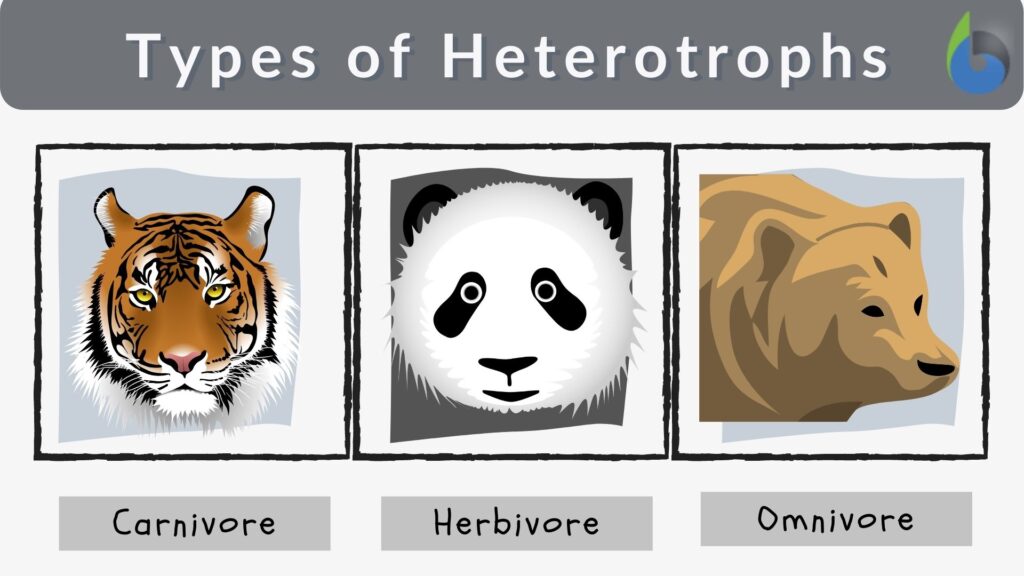
Other trophic levels
The organism that feeds on a secondary consumer is called a tertiary consumer and the one that eats on a tertiary consumer is referred to as a quaternary consumer. The tertiary consumers and the quaternary consumers occupy trophic levels 4 and 5, respectively.
Decomposers
The last of the trophic level is occupied by decomposers, such as detritivores. They feed on dead plants and animal matter. Detritivores are decomposers that specifically fragment to consume their food. Examples of detritivores are worms, millipedes, dung flies, woodlice, and slugs. Other decomposers include fungi and bacteria. They consume nutrients at the molecular level as opposed to other consumers that eat their food and digest them. These decomposers rely on readily available nutrients in the simplest form, e.g. materials that have been digested or substrates derived from deceased or rotting organisms. Parasites that feed on available organic materials but do not necessarily kill the host may also be included in this group.
Decomposers occupy the last trophic level or the top of the ecological pyramid. The most common decomposers are fungi. They are the first instigators of decomposition. They have the enzymes and other compounds to break down the biomolecules of the deceased organism. Bacteria also have enzymes that break down organic compounds into simpler forms. After the decomposition process, the detritivores then act on the remains, scavenging for detritus or decomposing organic matter. The role of decomposers in the ecosystem is vital as they are the ones that break down the organic matter of dead organisms where a part of them returns to earth as a geochemical component.
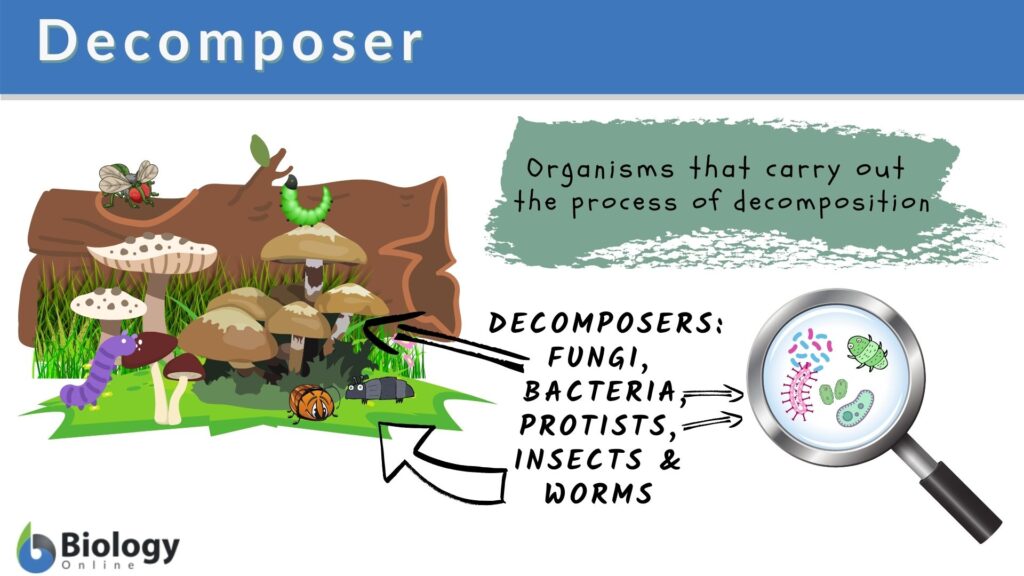
Planktons
Planktons are microscopic organisms that live in aquatic habitats. Some of them are photosynthetic and others are heterotrophs. Thus, they may be distributed to different trophic levels in the food chain or ecological pyramid. Those that are capable of photosynthesis, such as phytoplankton, are considered producers. Heterotrophic plankton, such as zooplankton may be consumers as they feed on other plankton. (5)
Biomass Transfer Efficiency
Biomass in an ecological pyramid is lost progressively from the bottom up. The greatest biomass amount is found at the base trophic level which includes the producers. Since the primary consumers rely on producers for sustenance, the biomass amount of the producers would, therefore, be a limiting factor to the biomass of the primary consumers.
Likewise, the secondary consumers rely on primary consumers, and consequently, their biomass would also be affected by the available biomass amount of primary consumers. Thus, in an ecosystem, it is usual to find a biomass pyramid wherein the first trophic level is the widest while the topmost trophic level is the narrowest.
The distribution of biomass in an ecosystem implicates ecosystem stability. If in the case of an inverted pyramid, the ecosystem could fail when there are more consumers than primary producers.
Significance
Monitoring the trophic levels is essential so as to gain an understanding of the interrelationships between organisms as well as the ecological processes that occur within an ecosystem. In that way, the magnitude of herbivory, predation, and decomposition processes could be used to know the status and stability of an ecosystem.
NOTE IT!
Trophic Cascades — Shaping the Ecosystem
The ecological processes in which changes in the abundance or behavior of organisms at one trophic level result in indirect effects on multiple other trophic levels within an ecosystem are referred to as trophic cascades.
Changes in trophic cascades could alter species composition and structure in an ecosystem as well as the physical landscape of the environment.
An example scenario is the introduction of a non-native apex predator, the brown tree snake (Boiga irregularis). As seen in Guam, this led to intensified hunting activity of native birds, which, unfortunately, are not adapted to defending themselves well from the new predator.
As the population of the brown tree snake thrived, the population of the native birds declined.
These birds are essential pollinators and agents of seed dispersal. With the decline of such birds, the plant structure of the ecosystem could shift into a new structure over time. This, in turn, could likely affect other animals that feed on them.
The shift to a new trophic level structure has the tendency to influence not just the area’s flora and fauna but also soil nutrient levels, further altering the shape of the ecosystem.
Video: When snakes outnumbered humans on the island!
The brown tree snakes were accidentally introduced via a military vessel back to their port.
“Since they were introduced, there has been a cascading effect. They eat the birds; fewer birds means more pests and diseases and then there are no native birds to spread native seeds – that’s another big impact.” — Megan Parker, a natural resources specialist with Joint Region Marianas. [NEWS SOURCE]
Take the Trophic Levels – Biology Quiz!
See also
References
- Preisser, E. (2008). Trophic Structure. Encyclopedia of Ecology, 3608–3616. https://doi.org/10.1016/b978-008045405-4.00558-9
- Predator-Prey Relationships — New England Complex Systems Institute. (2014). New England Complex Systems Institute. Retrieved November 16, 2019, from New England Complex Systems Institute website: https://necsi.edu/predator-prey-relationships
- “Omnivore”. National Geographic Education. National Geographic Society. Retrieved from http://education.nationalgeographic.com/education/encyclopedia/omnivore/?ar-a=4&ar-r=3
- McArdle, Ph.D., John (May–June 1991). “Humans are Omnivores”. Vegetarian Journal (The Vegetarian Resource Group).
- Is Plankton a Producer or Decomposer? (2019). Retrieved from Reference website: https://www.reference.com/pets-animals/plankton-producer-decomposer-b38db29bb175772b
© Biology Online. Content provided and moderated by Biology Online Editors

